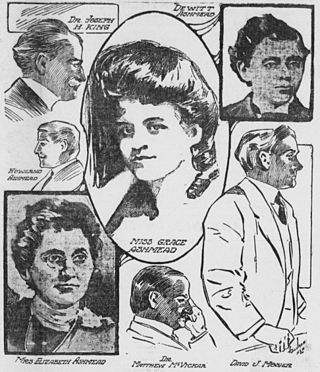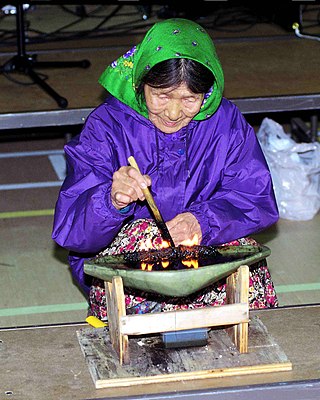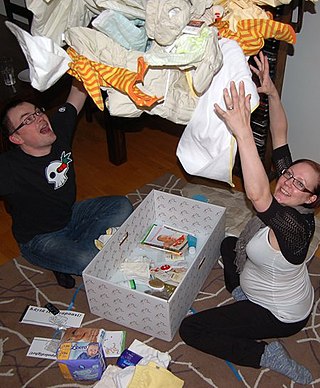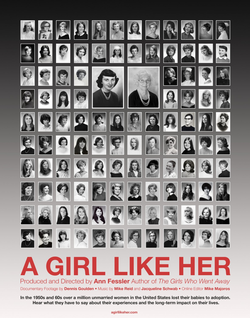Related Research Articles
Open adoption is a form of adoption in which the biological and adoptive families have access to varying degrees of each other's personal information and have an option of contact. While open adoption is a relatively new phenomenon in the west, it has been a traditional practice in many Asian societies, especially in South Asia, for many centuries. In Hindu society, for example, it is relatively common for a childless couple to adopt the second or later son of the husband's brother when the childless couple has limited hope of producing their own child.

Beulah George "Georgia" Tann, was an American social worker and child trafficker who operated the Tennessee Children's Home Society, an unlicensed adoption agency in Memphis, Tennessee. Tann used the home as a front for her black market baby adoption scheme from the 1920s to 1950. Young children were kidnapped and then sold to wealthy families, abused, or—in some instances—murdered. A state investigation into numerous instances of adoption fraud led to the closure of the institution in 1950. Tann died of cancer before the investigation made its findings public.

The National Florence Crittenton Mission was an organization established in 1883 by Charles N. Crittenton. It attempted to reform prostitutes and unwed pregnant women through the creation of establishments where they were to live and learn skills.

Sister Irene was an American nun who founded the New York Foundling Hospital in 1869, at a time when abandoned infants were routinely sent to almshouses with the sick and insane. The first refuge was in a brownstone on E.12th St. in Manhattan, where babies could be left anonymously in a receiving crib with no questions asked. The practice was an echo of the medieval foundling wheel and an early example of modern "safe haven" practices.

The Ideal Maternity Home was a maternity home in the Canadian province of Nova Scotia, operated from 1928 until 1947 by William Peach Young, a chiropractor and unordained minister of the Seventh-day Adventist Church, and his wife Lila Gladys Young, a midwife, although she advertised herself as an obstetrician. The business was eventually shut down by the government.
The Girls Who Went Away: The Hidden History of Women Who Surrendered Children for Adoption in the Decades Before Roe v. Wade is a 2006 book by Ann Fessler which describes and recounts the experiences of women in the United States who relinquished babies for adoption between 1950 and the Roe v. Wade decision in 1973.

Child harvesting or baby harvesting refers to the systematic sale of human children, typically for adoption by families in the developed world, but sometimes for other purposes, including trafficking. The term covers a wide variety of situations and degrees of economic, social, and physical coercion. Child harvesting programs or the locations at which they take place are sometimes referred to as baby factories or baby farms.

The Inuit are indigenous people who live in the Arctic and subarctic regions of North America. The ancestors of the present-day Inuit are culturally related to Iñupiat and Yupik, and the Aleut, who live in the Aleutian Islands of Siberia and Alaska. The word "Eskimo" has been used to encompass the Inuit and Yupik, and other indigenous Alaskan and Siberian peoples, but this usage is in decline.

Coin-operated-locker babies or coin-locker babies are victims of child abuse often occurring in Japan, in which infants are left in public lockers. There are two main variables that account for the differences in frequency and the type of these child abuse cases: social and economical. Predominantly neonates and male babies, the murder of infants became a form of population control in Japan, being discovered 1–3 months after death, wrapped in plastic and appearing to have died of asphyxiation. The presumption is that such lockers are regularly checked by attendants and the infant will be found quickly; however, many children are found dead. Between 1980 and 1990, there were 191 reported cases of infants which died in coin-operated lockers, which represents about six percent of all infanticides during that period.
The Sixties Scoop, also known as The Scoop, was a period in which a series of policies were enacted in Canada that enabled child welfare authorities to take, or "scoop up," Indigenous children from their families and communities for placement in foster homes, from which they would be adopted by white families. Despite its name referencing the 1960s, the Sixties Scoop began in the mid-to-late 1950s and persisted into the 1980s.
The following outline is provided as an overview of and topical guide to adoption:

Unwed Mother is a 1958 American drama film directed by Walter A. Doniger and starring Norma Moore, Robert Vaughn, Billie Bird, Diana Darrin and Jeanne Cooper.

The maternity package, known internationally as the Finnish "baby box," is a kit granted by the Finnish social security institution Kela, to all expectant or adoptive parents who live in Finland or are covered by the Finnish social security system. The package contains children's clothes and other necessary items, such as nappies, bedding, cloth, gauze towels and child-care products. It was first issued in 1938 to parents with a low income, and contained a blanket, crib sheets, diapers, and fabric which parents could use to make clothing for the baby.
Concerned United Birthparents, Inc. (CUB), a non-profit organization established in 1976, is one of two primary nationwide organizations offering support to the biological parents of adopted people in the United States. The organization is credited with the creation of the term "birthparent."
A maternity home, or maternity housing program, is a form of supportive housing provided to pregnant women. Maternity housing programs support a woman in need of a stable home environment to reach her goals in a variety of areas including education, employment, financial stability, prenatal care, and more. There are over 400 maternity homes in the United States ranging in size and criteria for admittance. Staffing model is a primary way that maternity homes differ. The three major staffing models are houseparents, live-in staff, and shift staff. Additionally, there are a limited number of maternity housing program who operate as a "shepherding" or "host" home. In the "host home" model, women are connected to screened households that offer to provide housing.
Rickie Solinger is an independent historian, curator, and lecturer whose work focuses on reproductive politics, welfare politics, politics of incarceration, race and class, and motherhood. She is the author of Wake Up Little Susie: Single Pregnancy and Race before Roe v. Wade, The Abortionist: A Woman Against the Law, Beggars and Choosers: How the Politics of Choice Shapes Adoption, Abortion, and Welfare in the U.S., Pregnancy and Power: A Short History of Reproductive Politics in America, Reproductive Politics: What Everyone Needs to Know, and, with co-author Loretta Ross, "Reproductive Justice: An Introduction," as well as articles about reproductive politics and welfare politics. Solinger curates art exhibitions associated with the themes of her books; the shows travel to college and university galleries around the country aiming to interrupt the curriculum.

A Girl Like Her is a 2012 American documentary film by Ann Fessler about women who lost children to adoption in the United States between the end of World War II and the early 1970s due to the social pressures of the time, in a period now known as the Baby Scoop Era. Fessler combines the voices of the women with footage from educational films and newsreels about dating, sex, “illegitimate” pregnancy and adoption. The women's stories unfold over footage of life in post-World War II America. Educational films offer guidance about dating and sex, and scripted newsreels shed light on adoption in an era when secrecy prevailed and adoptable babies were thought to be “unwanted” by their mothers. As the footage illuminates the past, the women's stories form a collective narrative as they recount their experiences of dating, pregnancy, family reaction, banishment, and the long-term impact of surrender and silence on their lives.
Birth mothers in South Korea (international adoption) refers to the group of biological mothers whose children were placed for adoption in South Korea's international adoption practice. The decades-long phenomenon of international adoption in South Korea began after the Korean War. In the years since the war, South Korea has become the largest and longest provider of children placed for international adoption, with 165,944 recorded Korean adoptees living in 14 countries, primarily in North America and Western Europe, as of 2014.
The Milford Industrial Home, formerly called Nebraska Maternity Home, was an institution in Milford, Nebraska, which housed unmarried pregnant women. For a while it was the only such institution in the country. It was founded by an act of the Nebraska Legislature in 1887, and the first woman was admitted in 1889. The women were under strict rules, and were encouraged to place their babies for adoption. They stayed there, usually under court order, for a period of a year. The home closed in 1954; it is estimated that over 4,000 babies were born there.
The Castlepollard Mother & Baby Home that operated between 1935 and 1971 in the town of Castlepollard, County Westmeath, Ireland, was a maternity home for unmarried mothers and their children in the former Kinturk Demesne or Manor previously owned by the 'Old English' Pollard family. The Home was run by the Sisters of the Sacred Hearts of Jesus and Mary, a religious order of Catholic nuns.
References
- ↑ The Baby Scoop Era Research Initiative
- ↑ "Adoption Statistics". The Adoption History Project. University of Oregon. Retrieved 17 October 2014.
- ↑ Pelton, L. (1988). "The Institution of Adoption: Its Sources and Perpetuation" in Infertility and Adoption, A Guide for Social Work Practice, Deborah Valentine, Editor. (pp. 88–89)
- 1 2 Maza, P.L. (1984). Adoption trends: 1944–1975. Archived 2009-10-19 at the Wayback Machine Child Welfare Research Notes #9. Washington, D.C.: Administration for Children, Youth, and Families, 1984.
- ↑ "U.S. Department of Health and Human Services, Child Welfare Information Gateway (2005). Voluntary Relinquishment for Adoption: Numbers and Trends". Archived from the original on 2007-08-19. Retrieved 2007-10-23.
- ↑ Solinger, R. (2000). Wake Up Little Susie: Single Pregnancy and Race Before Roe v. Wade. (p. 88)
- ↑ Petrie, A. (1998). Gone to an Aunt's: Remembering Canada's Homes for Unwed Mothers. (pp. 7–8)
- ↑ O'Shaughnassy, T. (1994). Adoption, Social Work, and Social Theory (p. 115)
- ↑ Mandell, B. (2007). "Adoption." Archived 2007-05-19 at the Wayback Machine New Politics, Vol. 11, No. 2, Winter 2007, Whole No. 42
- ↑ Solinger, R. (2000). Wake Up Little Susie: Single Pregnancy and Race Before Roe v. Wade. (p. 95)
- ↑ Ellison, M. (2003). "Authoritative Knowledge and Single Women's Unintentional Pregnancies, Abortions, Adoption and Single Motherhood: Social Stigma and Structural Violence". Medical Anthropology Quarterly. 17 (3): 322–47. doi:10.1525/maq.2003.17.3.322. PMID 12974201.
- ↑ Celeste Billhartz. "About The Mothers Project ..." The Mothers Project. Archived from the original on 2008-09-05. Retrieved 2007-10-22.
- ↑ "More Adoption Support". BillFinch.com. April 15, 2006. Archived from the original on 2007-10-16.
- ↑ Betty Reid Mandell. "Adoption". New Politics. XI (2). Archived from the original on September 22, 2008. Retrieved April 8, 2016.
- ↑ Lohmann, B. "World of Adoption; Forced to Give Up Her Baby, She Now Opposes Adoption," Richmond Times-Dispatch , November 21, 2004, p. G-1.
- ↑ Brozinsky, A. (1994). "Surrendering an Infant for Adoption: The Birthmother Experience". In The Psychology of Adoption, D. Brozinsky and M. Schechter (Eds.). New York: Oxford University Press. (p. 297)
- ↑ Chandra, A., Abma, J., Maza, P., & Bachrach, C. (1999). "Adoption, adoption seeking, and relinquishment for adoption in the United States". Advance Data (No. 306) from Vital and Health Statistics of the Centers for Disease Control and Prevention, National center for Health Statistics, U.S. Department of Health and Human Services. Retrieved February 16, 2005.
- ↑ "Trackers International, "Survey 1000"". Archived from the original on 2007-10-12. Retrieved 2007-10-17.
- ↑ Shawyer, J. (1979). Death by Adoption
- ↑ Moor, M. (2007). Silent Violence: Australia's White Stolen Children Archived 2008-11-21 at the Wayback Machine . A thesis submitted in fulfilment of the requirement for the Doctorate of Philosophy in Arts, Media and Culture at Griffith University, Nathan, Qld.
- ↑ Petrie, A. (1998). Gone to an Aunt's: Remembering Canada's Homes for Unwed Mothers.
- ↑ Williams, Leigh Ann (May 13, 2014). "Taken". Anglican Journal. Retrieved July 20, 2014.
- ↑ Dorothy Howarth, “Mothers not all unhappy”, The Toronto Telegram, November 22, 1956.
- ↑ Reder, D. (2007). Indian re:ACT(ions) Archived 2007-10-21 at the Wayback Machine University of British Columbia
- ↑ Lyons, T. (2000). "Stolen Nation," in Eye Weekly, January 13, 2000. Toronto Star Newspapers Limited.
- ↑ Parliamentary Paper No. 366, Standing Committee on Social Issues, Report on Adoption Practices, Second Interim Report, Transcripts of Evidence, 16 June 1999 – 25 October 1999